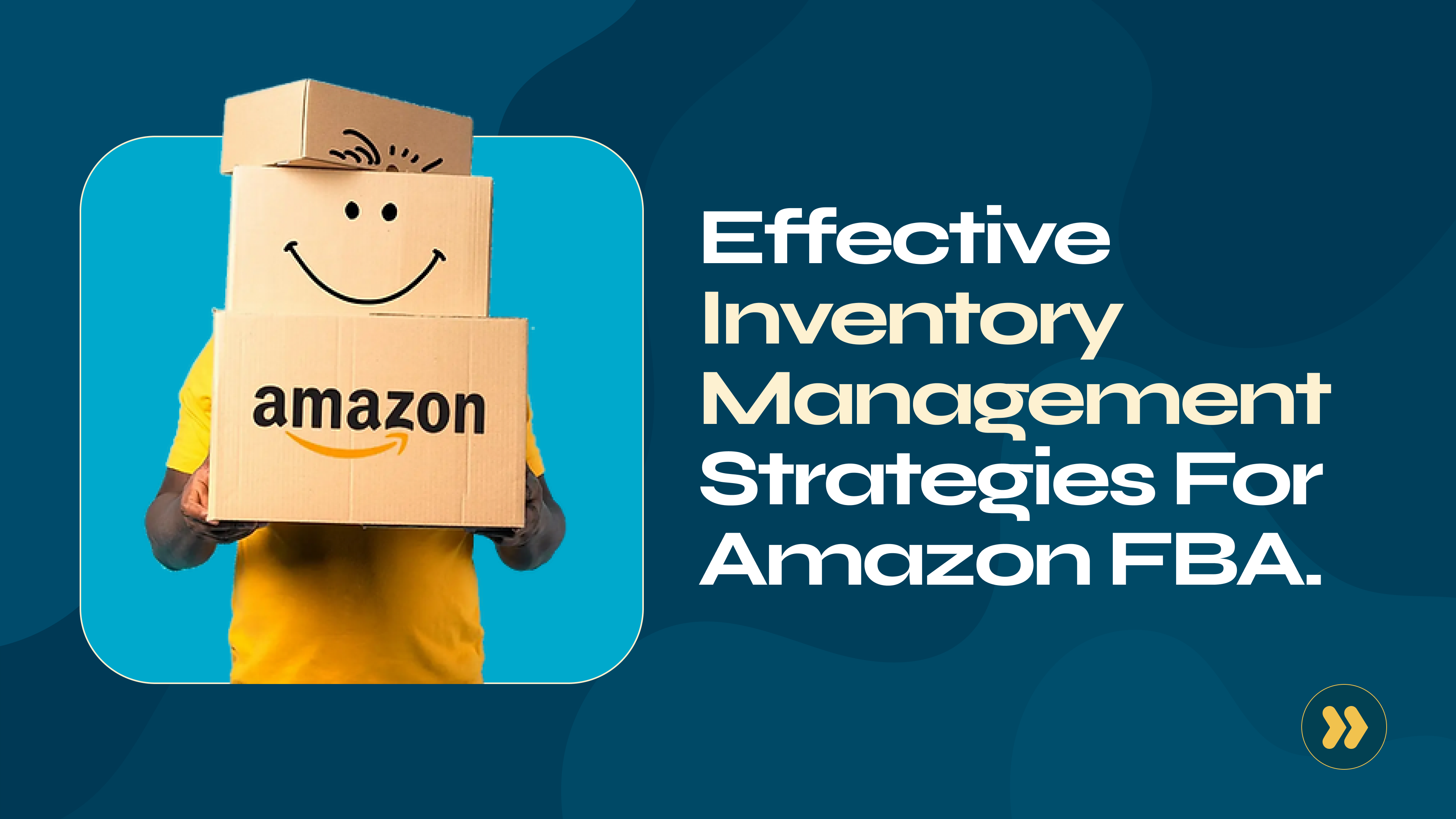Effective inventory management strategies for Amazon FBA

As an Amazon seller, you will quickly learn that effective inventory management is an essential part of the business. With it, you get to reduce the chances of losing sales because you're out of stock or accruing storage costs because you overstocked your inventory.
Effective inventory management is all about finding the balance between low stock levels and overstocking. In this article, we will go over some of the best strategies you can use to ensure your inventory levels are well-managed.
But before then, let's understand the concept of inventory management.
What is Inventory Management?
Inventory management is the process of overseeing the ordering, storage, and use of products that a company will sell. It manages the flow of goods from suppliers to warehouses and warehouses to customers. Effective inventory management ensures a business has the right products in the right quantities at the right time.
In the context of Amazon FBA (Fulfillment by Amazon), inventory management specifically refers to managing the stock levels of products stored in Amazon's fulfilment centres. This means monitoring your inventory at Amazon, ensuring there's enough to meet customer demand without too much, which will attract huge storage costs.
Related: Everything You Need to Know About Using Amazon FBA as a Nigerian Business Owner
Why is Inventory Management Crucial for Amazon FBA Sellers?
Meeting Customer Expectations:
The rise of eCommerce also came with a rise in customer expectations. Your online customers are not so loyal to wait while you deal with inventory issues. In fact, only 44% of online shoppers said they are willing to wait two days for delivery. So think about it: if the larger percentage of people will not wait to get their delivery in two days, will they wait while you are out of stock? Once there is a stockout, they will shop at your competitors' stores. This spells lost sales for you, an increase in your competitor’s ranking and visibility, while yours decreases.
Profitability:
Nine of Ten eCommerce sellers are in the business to make a profit, which drives everything they do. But when overstocking occurs, your capital becomes tied, increasing the money paid in storage fees. When your inventory is tied up and storage costs keep rising, it eats into your profit margins and leaves you at a loss. Effective inventory management allows you to avoid such situations and have your money work for you.
Efficiency:
Effective inventory management helps you forecast demand, plan reorders, and optimise stock levels. This reduces manual work, minimizes errors, and frees up time for other aspects of your business.
Amazon's Algorithm and Visibility:
Amazon's search algorithm favours sellers with products that are consistently in stock and have a good sales history. Maintaining healthy inventory levels can improve your product's ranking and visibility in search results.
Common Inventory Challenges for Amazon FBA Sellers
Low Stock Levels (Stockouts):
Low stock levels happen when you run out of a product. This leads to lost sales, as customers cannot buy what you don't have in stock and turn to your competitors. Stockouts can damage your seller rating and decrease your product's visibility in Amazon's search results.
Overstocking:
Overstocking means having too much inventory, which can cause issues such as increased storage and tied-up capital that cannot be used for other business needs. There is also a risk of products becoming outdated or unsellable if they sit in storage for too long.
Aged Inventory:
Aged inventory refers to products that remain unsold in Amazon's fulfilment centres for an extended period, typically over six months. Amazon imposes hefty long-term storage fees for aged inventory and can trigger automatic removals.
Stranded Inventory:
Stranded inventory refers to products that are technically in Amazon's fulfilment centres but are unavailable for sale due to listing errors, quality issues, or restrictions on certain products. Stranded inventory occupies valuable storage space, accumulates fees, and cannot generate revenue. Here’s how you can fix stranded inventory.
Storage Costs:
Amazon charges monthly inventory storage fees based on the volume of your products. If your inventory stays longer than 90 days in the Amazon warehouse, they consider it as excess inventory and start charging you for it–long-term storage fees. These fees can impact your profit margins and even add up to be costlier than the inventory you have in their warehouse.
How to Increase Your Amazon Storage Capacity
Tips for Properly Managing Inventory on Amazon FBA
Maintain Good Supplier Relationships:
Except you produce your inventory, your suppliers are responsible for bringing your product ideas to life and ensuring you have enough inventory for each supply cycle. Good supplier relationships allow you to negotiate better terms, get the best prices and payment conditions, prioritise your order, and ensure you are getting quality products.
Also, as your relationship deepens, you are assured of reliable lead times to keep your stock levels steady and prevent stockouts.
Maintain a Below 90-Day Supply:
One of the hacks to effective inventory management is balancing low stock levels and overstocking. One way to do this is to ensure that your inventory doesn’t exceed 90 days, as Amazon rewards sellers who maintain lower inventory levels with reduced storage fees. By keeping your stock levels under 90 days, you can avoid long-term storage fees and reduce the risk of having excess inventory that doesn’t sell quickly.
Use Technology to Forecast Demand:
Using technology to forecast demand is essential for making informed decisions. Leverage inventory management software and Amazon's reporting tools to analyse sales trends. These tools help you understand which products are selling well and which are not, allowing you to make data-driven decisions about reordering and stocking levels. Accurate demand forecasting helps prevent both stockouts and overstocking.
Related: 6 Amazon Seller Mistakes And How To Avoid Them
Get Rid of Excess Inventory:
If you have excess inventory because you probably overestimated your sales volume, you don’t have to beat yourself up because it happens to everyone. When faced with this issue, the best way is to eliminate excess inventory. You can do this by:
- Offering discounts and promotions on the inventory,
- Increase your advertising effort.
- Create a removal order and move the inventory to another warehouse.
- Liquidate the inventory. This should be your last resort, as you must try every means to recover some of your investment.
Adjust Product Demand:
If your stock levels are low and you’re unsure when your next inventory will arrive, you can adjust product demand so you don’t run out of stock. One of the ways you can do this is to halt all your advertising campaigns until you get new products. You can also slightly increase your price. This will help you keep off new customers. When you have stocked up, you can resume your advertising campaigns and return to your normal price.
Regularly Monitor Inventory Health:
Regularly monitoring your inventory health is crucial. Use the Amazon Inventory Dashboard and Inventory Performance Index (IPI) to monitor your inventory status. These tools help you identify potential issues, such as low stock levels or excess inventory, so you can take corrective action promptly. Regular monitoring ensures that your inventory remains in good shape and helps you avoid unnecessary costs.
Last Words
Effective inventory management is a cornerstone of success for Amazon FBA sellers. You can maintain a healthy and profitable inventory by understanding and proactively addressing common challenges like stockouts, overstocking, demand forecasting difficulties, aged inventory, stranded inventory, and storage costs.
It's important to remember that inventory management is not a one-time task but an ongoing process. Market trends, customer preferences, and global events can impact demand and supply. So, you have to remain adaptable and continuously refine your inventory management strategies to meet your business's evolving needs and the ever-changing marketplace.
If you found this helpful, you will enjoy more helpful articles and guides when you sign up on the Heroshe blog.

